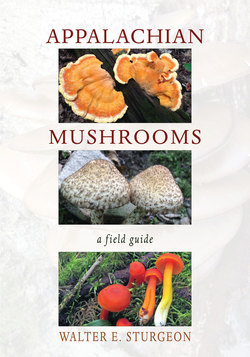Читать книгу Appalachian Mushrooms - Walter E. Sturgeon - Страница 10
ОглавлениеINTRODUCTION
Mushrooms and Macro Fungi
ALL OF THE fleshy and woody fungi fruit bodies in the woods and fields are there for one purpose, reproduction. Microscopic spores are produced somewhere on the fruit body. The part of the organism that produces these reproductive structures is mostly unseen in the substrate as it goes about its lifestyle of procuring nutrients in a saprobic, parasitic, or symbiotic manner. These hidden filaments or strands are known collectively as mycelium. When in the soil or humus, the mycelium can cover large areas. Without chlorophyll and unable to produce its own food, the fungal mycelium uses chemicals to break down its food and then absorbs the nutrients through its cell walls. The mycelium in some mushroom species forms a coating on plant roots, where there is a symbiotic relationship called mycorrhiza. In other species the mycelium is parasitic, aggressively attacking a living plant, insect, or other fungus, killing the host and using it for food. Many macro fungi are saprobes, obtaining their nutrients from dead plant material. They are nature’s primary recyclers. Many macro fungi can be parasitic at times and saprobic at other times. Some mycorrhizal fungi can also be saprobic at times.
The terms mushroom, toadstool, fleshy fungus, and macro fungi all refer to the reproductive organ of a fungus but could also refer to the organism itself. None of these terms have a scientific meaning. Non–macro fungi include molds, rusts, mildews, and yeasts. These fungi do not produce large fruiting bodies. Defining the fungus kingdom is difficult. Simply stated, a fungus is a stationary organism that reproduces by spores, lacks chlorophyll, and can’t produce its own food. It is neither a plant nor an animal. The fungi kingdom is huge and diverse. Mushrooms and macro fungi are a great introduction to the vast world of fungi. In the following pages the reader should learn to identify and eat distinctive edible species as well as to identify and avoid poisonous mushrooms. More important, the book should help the reader discover the ecology and beauty of these colorful and fascinating life forms that are all around us but are all too often overlooked.
Mushroom taxonomy continues to evolve, which has resulted in the occurrence of many synonyms. A scientific name is created by the person who described the species and published the description in a scientific journal. The name, often abbreviated, follows the species name. Name changes result from new taxonomic information or discovery that the species had previously been published with a different name. Those synonyms selected for use here are the ones the reader is most likely to encounter in recent field guides. The term “Misapplied Name” refers to a name that was commonly used for a mushroom but was discovered to belong to another, similar-looking species.
